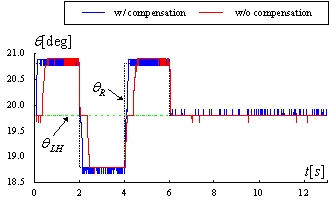Electronic Throttle Control
Electronic throttle (or throttle-by-wire) represents a DC servo-drive with embedded chopper that positions the throttle plate, thus controlling the airflow into the intake manifold of the spark-ignited automotive engine. It is increasingly replacing the conventional mechanic throttles, in order to provide implementation of engine-based vehicle dynamics control system, and to improve vehicle drivability, fuel economy, and emissions. In comparison with traditional DC servo drives, the electronic throttle includes some specific design characteristics such as the absence of the inner current control loop, the use of a potentiometer as a position sensor, and the presence of the highly nonlinear return spring which constrains the throttle motion.
Experimental identification and control of an electronic throttle has been extensively investigated within the Automotive Control Group. Detailed off-line experimental identification of the electronic throttle body (ETB) has been carried out with the aim to determine the structure and parameters of ETB model in support to design of a high performance electronic throttle control strategy. The linear and nonlinear parts of the electronic throttle process model have been conveniently identified separately. Identification of linear process dynamics includes a multi-step identification method based on physical ETB model form, and single-step methods based on black-box continuous integral+lag (IT1) model and discrete-time ARX process model. The nonlinear effects identified include different static and dynamic friction effects, and distinctive limp-home nonlinearity of the dual return spring.
The developed electronic throttle control strategy can be structured in four layers (see figure below). The basic control layer includes a PID feedback controller, a feed-forward controller (FFC) which speeds-up the reference response, and a PID controller gain-scheduling algorithm which accounts for different return spring stiffness for the regions below and above the limp-home position. The second control layer includes a nonlinear feedback compensator of friction and limp-home effects. These two control layers represent the core of the electronic throttle control strategy.
The developed electronic throttle control strategy has been applied to SI engine idle speed control. Analytical design of PI, PID, and polynomial controllers has bee considered. The proposed idle speed control system has been verified experimentaly.

The control strategy is extended in the third layer with an auto-tuning procedure. The auto-tuner provides on-line calculation of the control strategy parameters without any prior knowledge of the process parameters required. It can be executed for each single electronic throttle body (ETB) in the stage of vehicle production and during the vehicle exploitation (e.g. each time when the engine is turned off), thus providing the optimal performance of the electronic throttle control system regardless of ETB production deviations, external conditions variations, and aging. The auto-tuner is characterized by high tuning accuracy, fast execution (about 1.5 second), and simplicity (only integer arithmetic required).
As a natural extension of the auto-tuning procedure, a self-tuning strategy is included in the fourth control layer. Different self-tuning algorithms are developed depending on the availability of armature current sensor and initial auto-tuning procedure. The self-tuning algorithms provide on-line adaptation of the control strategy with respect to variations of the process parameters, which can occur during a single engine run (e.g. variations of the DC motor armature resistance and the limp-home position). For the purpose of experimental examination of the proposed self-tuning strategy, a real-time simulator of the process parameter variations is developed, and implemented as a part of the control software.
The developed electronic throttle control strategy has been examined experimentally on an experimental setup of the electronic throttle control system. It has also been tested on a real engine in the framework of idle speed control. It is anticipated that the proposed control strategy can also be applicable to other X-by-wire electrical servosystems which are used as actuators in the interactive vehicle dynamics control systems.
Below figures illustrate the effectiveness of the proposed electronic throttle control strategy and embedded self-tuning algorithms.


for small signals operating mode.

for limp-home position passing.


and details of throttle position reference tracking with and without adaptation (b).
Publications
-
Control Engineering Practice, Vol. 14, pp. 121-136, 2006. -
Identification and Speed Control of SI Engine for Idle Operating Mode
SAE paper #2004-01-0898, 2004 SAE World Congress, Detroit, MI, 2004. -
An Adaptive Nonlinear Strategy of Electronic Throttle Control
SAE paper #2004-01-0897, 2004 SAE World Congress, Detroit, MI, 2004. -
An Electronic Throttle Control Strategy Including Compensation of Friction and Limp-Home Effects
IEEE Transactions on Industry Applications, Vol. 40, No. 3, pp. 821-834, 2004. -
Identification and Control of Electronic Throttle Drive
Master, 2003. -
Self-tuning Control of an Electronic Throttle
Proceedings of 2003 IEEE Conference on Control Applications (CCA 2003), Istanbul, Turkey, 2003. -
Automatic Tuning of Electronic Throttle Control Strategy
Proceedings of 2003 Mediterranean Conference on Control & Automation (MED 2003), Rhodes, Greece, 2003. -
An Electronic Throttle Control Strategy Including Compensation of Friction and Limp-Home Effects
Proceedings of IEEE International Electric Machines and Drives Conference (IEMDC 2003), Madison, WI, 2003. -
Experimental Identification of an Electronic Throttle Body
Proceedings of 10th European Conference on Power Electronics and Applications (EPE 2003), Toulouse, France, 2003. -
Analysis and Optimization of an Electronic Throttle for Linear Operating Modes
10th International Power Electronics and Motion Control Conference (EPE-PEMC 2002), Dubrovnik-Cavtat, Croatia, 2002.